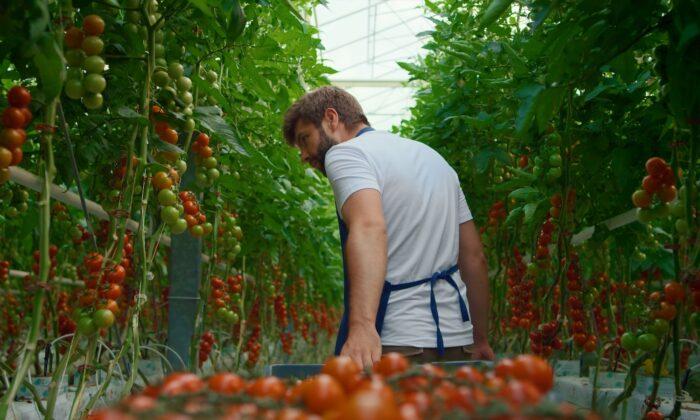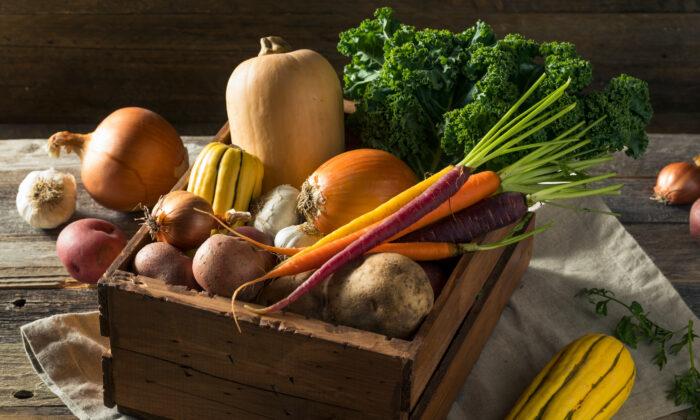Improving soil health is an overlooked key for nutrient-dense food and a healthier planet, and we can support farming that has this focus through the products we purchase.
Whether you’re familiar with the term or not, regenerative agriculture is a top food trend this year. It’s of growing interest to consumers, particularly when it’s presented with the benefits that go with it, including improving soil health, producing more nutritious foods, conserving water, and positively impacting resilience to extreme weather events.
Degenerative Versus Regenerative
In many areas of the world where crops historically have been grown, a process called “desertification” is occurring: Land has turned, or is turning, into desert or bare ground, as shown in the movie “Kiss the Ground.” Chemical fertilizers, herbicides, pesticides, and other farming practices such as plowing (tilling) have killed off microorganisms in the soil resulting in living, fertile soil becoming dirt.Because dirt is depleted of nutrients and important microorganisms, it doesn’t efficiently absorb water, floods easily, leads to toxic runoff of the chemicals used, can’t withstand weather extremes such as drought or heavy rain or wind, and produces poor quality food or no food at all.
Picture the Dust Bowl in the Great Plains in the 1930s. This is happening in many places throughout the world on a much greater scale. Our current modern industrial agriculture is a degenerative form of agriculture. Unsustainable forms of intensive agriculture conducted in the driest, and often poorest, regions of the world can leave the land depleted and vulnerable to the ecological collapse of desertification. The result is barren, inhabitable land.
Essential Benefits of Healthy Soil
According to “Growing Life: Regenerating Farming and Ranching” by André Leu, the international director of Regeneration International, the agricultural and environmental benefits of improved soil health include:- Increased efficiency in the soil’s water-holding capacity, so less watering is needed;
- Better resilience to droughts, floods, wind, and other extreme weather events;
- Fewer diseases, due to beneficial soil microorganisms controlling pathogens;
- Increases in the bioavailability of the nutrients that plants, animals, and humans need.
Benefits of Regeneratively Grown Food
A 2022 study published in the journal PeerJ indicates an advantage that most people have long suspected from improved soil health: nutritional benefits. The study compared the nutritional content of food crops grown using regenerative versus conventional farming practices. The goal of the study was to get direct comparisons with the same crop, the same climate, the same weather, and the same soil type, but the soil had been farmed quite differently for at least five years on the regenerative farms.The results of the comparisons showed that foods grown on the regenerative farms contained, on average more magnesium, calcium, potassium, and zinc; more vitamins (including B1, B12, C, E, and K); and more phytochemicals—compounds that provide desirable health benefits beyond basic nutrition to reduce the risk of major chronic diseases.
The authors of the PeerJ study conclude:
Ways to Shop for Regeneratively Grown Foods
As a consumer, you can use your purchasing power to support regenerative agriculture that builds healthy soil, which, in turn, produces more nutritious foods, conserves water, and helps to regenerate the planet for future generations. Follow these regenerative-focused shopping tips.Buy Seasonally and Locally
Purchase seasonal, locally grown foods that have been grown in healthy soil. At farmers markets, ask local food producers if they practice techniques to regenerate the soil, such as no tilling, using cover crops, rotating crops, and adding compost. You can also search for regenerative, soil health-focused food producers in your area at RegenerationInternational.org and RealOrganicProject.org.Look for Grass-Finished Meat
Choose meat that is regenerating the land. Avoid commercial meat from animals that have been raised in unhealthy confined feedlots. Instead, seek out 100 percent grass-fed, grass-finished meat. If the label only says “grass-fed,” that most likely means the animal was “finished” in a feedlot on grains. A purchasing guide offered by “Kiss the Ground” suggests looking for these certifications:- American Grassfed Association (AGA Certified)
- Animal Welfare Approved
- Global Animal Partnership Certified (Steps 4 and 5)
Choose Regenerative Dairy
Choose dairy that comes from animals that are grass-fed and grass-finished and that are raised by ranchers who use managed or rotational grazing, regularly moving their animals onto different fields.Eat More Perennials
Add more perennial plant foods to your diet. Perennials are plants that live longer than two years. Some perennial trees and bushes even live for hundreds of years.Perennials establish deep roots in the soil, protecting the land and drawing down carbon year after year. Examples of perennials include walnuts, pecans, apples, oranges, asparagus, yams, olives, cacao, coffee, and tea.
Use Better Oils
Use avocado, coconut, or olive oil. These oils are made from perennial crops, as opposed to oils grown from annual crops, such as corn oil, soy oil, canola oil, peanut oil, and sunflower oil, which should be avoided. Choose organic avocado, coconut, and olive oils from companies that maintain strong environmental commitments.Seek Regenerative Products
Be on the lookout for products marketed as produced through regenerative agricultural practices. Two examples are Force of Nature 100 percent grass-fed and grass-finished meat and Serenity Kids certified organic baby food with ingredients sourced from small family farms that use regenerative agricultural techniques.One way to know if you’re buying such products is to look for the regenerative organic certified (ROC) label. ROC is a revolutionary new certification for food, fiber, and personal care ingredients. ROC farms and products meet the highest standards for soil health, pasture-based animal welfare, and farmworker fairness. ROC encompasses organic farming, then raises the bar, prioritizing improving soil health and building soil carbon.
Conclusion
We’re just at the beginning of a movement of regenerative-focused producers that’s expected to grow dramatically in the coming years.Consumers can find regenerative products at local farmers markets and ROC products wherever organic products are sold.
These products may be more expensive and harder to find, but being a responsible consumer is more important now than ever. At the very least, you will know your dollars are contributing to the rebirth of our planet rather than its destruction.






